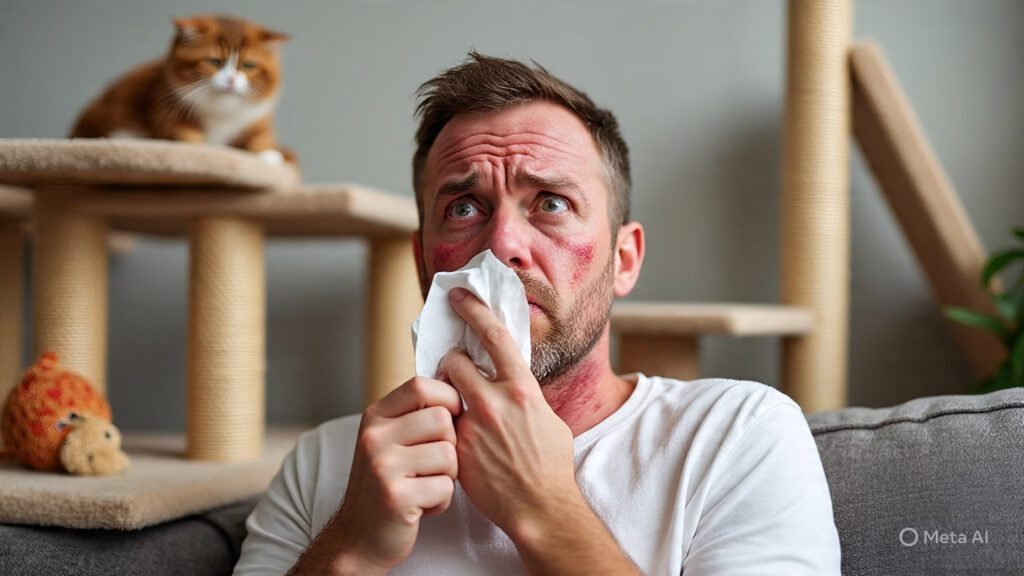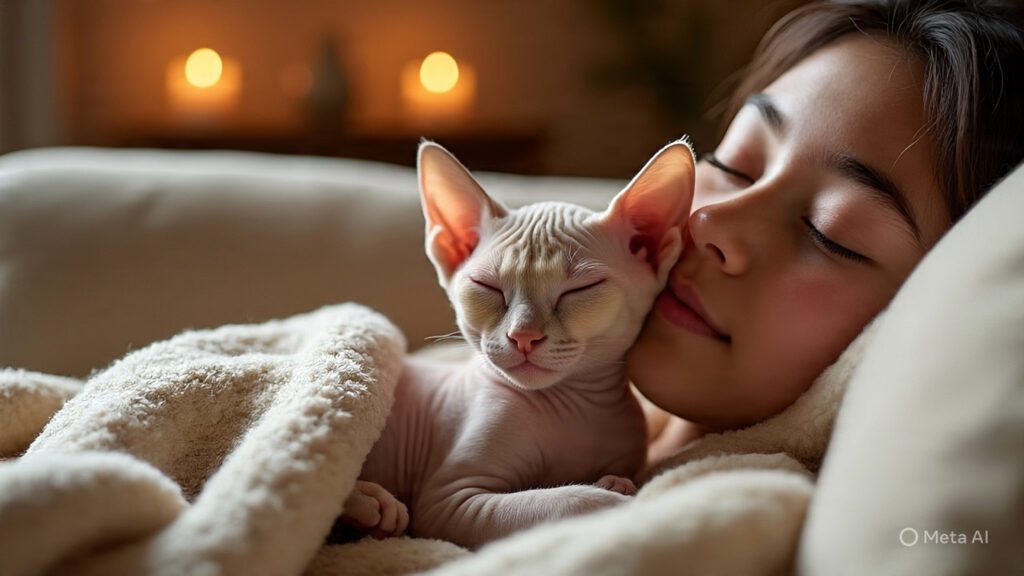Please Note: This post may contain affiliate links. If you click one of them, we may receive a commission at no extra cost to you. As an Amazon Associate, I earn from qualifying purchases.
Let's be honest: cats are cute, fluffy animals that can make our lives so much better. But occasionally they also come with sneezes and stinging eyes.
Yes, I mean allergies to cats! Don't panic if you adore your cat but are having trouble with the sniffles.
We're going to learn a lot about cat allergies, including what causes them and how to deal with them.
Top Takeaways and Key Concepts
- Cat allergies are caused by proteins in saliva, skin, and urine, not just fur.
- Common symptoms include sneezing, itchy eyes, coughing, congestion, rashes, or hives.
- Reduce exposure by designating cat-free zones and using HEPA air filters.
- Regular grooming and specialized brushes help remove dander and minimize allergens.
- Long-term solutions include medications, immunotherapy, and lifestyle changes to manage reactions.
Article Summary
The article explains that cat allergies stem from proteins in a cat’s saliva, skin, and urine, not solely fur. Symptoms often include sneezing, itchy eyes, congestion, or skin reactions. Managing exposure involves creating cat-free zones, using HEPA air purifiers, and maintaining regular grooming to reduce dander. Long-term strategies such as antihistamines, nasal sprays, and immunotherapy can reduce allergic responses over time. With careful planning, lifestyle adjustments, and preventive measures, individuals can enjoy living with cats while minimizing allergic reactions and maintaining a healthy, comfortable home.
Handy Amazon Shopping Directory for Cat Supplies
Cat Food - Cat Toys - Cat Health - Grooming - Carriers - Cat Beds - Apparel
Furniture - Cat Doors - Collars - Feeding/Watering - Flea/Tick Control - Treats
Video Summary
Jump to Content
What Makes People Allergic to Cats?

By the way, have you ever pondered why some people can cuddle with cats all day and others start to sound like a foghorn after just five minutes?
Proteins in cat saliva, skin, and urine are the main things that trigger cat allergies. When your cat cleans itself (which is like an Olympic sport for cats), those proteins get on its fur.
And you know what? If the fur falls off or gets blown away, it might make people with allergies react.
I really do think it's interesting how something so small can make such a large difference. These allergens can stay in the air for a long time, which is bad news for people with allergies.
Even if you don't have a cat but visit someone who does or just walk by one on the street, you could still be impacted by these annoying proteins that cause allergic reactions. It's astonishing how many individuals are allergic to cats, especially those who haven't been around them before.
Dander, which is basically fine dust made up of microscopic bits of dead skin cells that cats shed, is one of the main culprits in this case. This dander can readily get into the air and stay there, making it hard for people with allergies to get away from it. Dander can cause a lot of different problems when it is breathed in or touches the skin. These problems include sneezing, irritated eyes, and even breathing problems.
But we can't forget about pee and spit! Cats groom themselves a lot, and when they do, they get saliva on their fur. When the cat shakes or moves around, the proteins in their saliva might also get into the air with the dander. So, even a short meeting with a cat, whether at a friend's house or in public, might put these allergens into your body.
If you're thinking about getting a hairless breed like the Sphynx to get around this problem, think again! Even though hairless cats don't shed fur, their skin oils and saliva can still cause allergies. Because Sphynx cats don't have fur, there is less dander in the air. However, they still need to be bathed regularly to keep oil from building up on their skin and releasing allergens.
In reality, a lot of people with allergies say that no breed is completely hypoallergenic. Some breeds may make less allergens than others, or their fur may be better at trapping allergens. However, how people react to allergies can vary a lot from person to person.
If you want to bring a cat into your house or just spend time with friends who have cats, you need to know how cat allergies work. Knowing about your allergies lets you take steps to lower your exposure, such washing your hands after petting a cat or utilizing air purifiers. This can help lessen allergic reactions while still enjoying the companionship of our furry friends.
Signs That You Are Allergic to Cats

Now that we know what causes allergies, let's talk about the indications and symptoms. Having itchy eyes and a runny nose is a big sign of love for a pet.
The main symptoms include sneezing, coughing, stuffy nose, and itchy, watery eyes. Some people may also get a rash or hives after being around the pet.
These problems can be as annoying as having a stuffy nose that makes it hard to breathe, like sucking on a straw. This is definitely something to think about when you want to cuddle with your cat while watching a movie.
A lot of individuals don't even know they're allergic until they've been around a cat or two for a few days.
It's funny how someone might be having a great day out with their new acquaintance and then come home and take all the Kleenex away after taking too many anti-histamines, as if they were best buddies.
If you've been thinking about being tested for allergies because you think you might have never done it before, making an appointment with an allergist could provide you some useful information—maybe even fodder for your overly dramatic memoirs! Think about how exciting it would be to learn the secret realities of how your body reacts to different allergens.
An allergist can do a number of tests to find out exactly what is making you feel bad. They will figure out if the pain and misery you had in certain places was because of your furry friends or if it was just because of other common things like pollen, dust mites, or mold that were in your home. Allergies are rarely simple; a lot of people find that they are susceptible to more than one allergen at a time.
For example, an allergist might use skin prick tests or blood tests to give you small amounts of different chemicals during allergy testing. The results can show a complicated network of sensitivities. For example, they might show that cats are making your problems worse, but they aren't the only ones. You can also find out that seasonal pollen or annoying dust mites are hurting your immune system.
It's not uncommon for people to have more than one allergy at the same time; I know this since I have five different ones myself! This discovery can be both a comfort and a source of stress. Knowing what causes your allergies helps you manage them better, but it also involves dealing with a wider range of ways to avoid and treat them.
Additionally, seeing an allergist may lead to personalized therapies that can make your life much better. They might propose modifications to your lifestyle, drugs like antihistamines or nasal sprays, or even immunotherapy treatments that will help you become less sensitive over time.
So why not move forward with this step toward clarity? It could not only make you feel better by reducing allergy-related suffering, but it could also make your personal story more interesting and complex. Just imagine how interesting it would be to tell the story of how learning the truth about your allergies helped you find yourself and become stronger. It would be the perfect material for an autobiography full of surprises!
What to Do If You Have Cat Allergies

We talked about the cause of the allergy and its effects on the last topic. Now, the key question is: how can we deal with this allergy? First of all, the good news is that there are ways to maintain Mr. Whiskers in your house without getting an allergy.
To be fair, you might need to make some modifications in order to get something back (don't worry, it will be worth it!). To begin, move your cats to a place where they can't share with you, like a bedroom or even a lounge where you spend a lot of time relaxing.
On the other side, pet owners will strongly contend that their furry friends are great at spreading their hair all over the place! It may feel like a never-ending fight against pet hair, but there are ways to deal with it that work. Regular grooming will assist protect your floors and chairs from becoming a fuzzy landscape and cut down on the amount of hair that gets around your house. Making regular appointments with a professional groomer to remove your pet's hair not only keeps your home clean, but it also gives you and your pet a great way to bond.
Using specific brushes made to cut down on dander during these grooming sessions can be very helpful. These brushes assist get rid of loose fur and dead skin cells while also stimulating your cat's skin, which encourages healthy fur development and blood flow. Your cat will probably prefer the attention and love they get during these grooming sessions, which will make it fun for both of you.
Another great strategy to fight the allergens that come with having pets is to use high-efficiency particulate air (HEPA) filters in your house. These amazing devices are made to catch even the smallest particles in the air, like pet dander, dust mites, pollen, and other allergies. You may greatly improve the quality of the air inside by buying HEPA filters for your heating and cooling systems or standalone air purifiers for certain areas. This means you may enjoy being with your cat without having to deal with symptoms like a stuffy nose or itchy eyes all the time.
You can also make areas of pure air in your home by putting HEPA filters in the right places. This will make it easier for you and your cat to rest together. Think about putting one near places where you and your pet spend a lot of time together, like the living room or bedroom. Not only will this make you more comfortable overall, but it will also let you enjoy those special times when you cuddle on the couch or play together without worrying about allergic reactions.
In the end, taking care of pet hair can seem hard at times, but regular grooming and savvy purchases of HEPA filtration systems make your home a healthy place for both you and your pet. You'll be able to enjoy all the benefits of having a pet, like cuddling on quiet afternoons, without sacrificing comfort or health!
Solutions That Last

In the end, let's talk about long-term solutions. Some people are willing to deal with the symptoms of cat allergies, but they don't want to be sad about not having friends. For example, there are growing markets for hypoallergenic cat breeds, which are said to cause fewer allergies because they are not traditional cats. However, there are no guarantees either.
Some patients, by the way, are able to fight it off by waiting and using the immunotherapy their doctors prescribe.
Kavitha said it was like teaching oneself not to laugh at the same joke after hearing it a lot of times. This is because the goal is to lower a person's overall response to an allergen by slowly getting them used to it.
There are a lot of drugs that can help with allergy problems today. Doctors sometimes give people antihistamines, decongestants, and nasal corticosteroids to help with the pain and discomfort caused by allergies. These medicines can help you enjoy your time with your cat more by making sneezing, itching, and congestion much less severe. Before starting any medicine, though, it's important to talk to a doctor to make sure it's right for you.
Along with taking medicine, making changes to your lifestyle can be very helpful in controlling allergy symptoms. For example, getting into the habit of washing your hands well after touching pets is a good method to avoid allergens. This easy habit stops you from getting dander or saliva from your hands on your face or other places where you spend time. In addition, cleaning the places you spend time in every day can greatly cut down on the buildup of allergens. Using a vacuum cleaner with a HEPA filter and dusting surfaces on a regular basis will help keep your home cleaner and less likely to cause allergies.
It's also good to have certain portions of your home pet-free, like bedrooms or other designated spaces, where you can go to get away from the allergies if they get too bad. You can still spend time with your cat in other parts of the house while you are in these safe spaces.
Last but not least, we need to learn how to love our cats unconditionally while also dealing with the sadness that allergies might cause. This takes time and understanding. Don't give up hope; even though allergies can be hard to deal with, the bond you have with your cat is very fulfilling. When you find comfort in those quiet times together, remember that every ounce of effort you put into dealing with these problems is worth it.
Picture yourself on a cold day, snuggled up under a large, warm blanket with your pet next to you, watching Netflix together. The love and happiness that comedy and dramatic dramas bring into your life make every sneeze or scratch seem small. We love our pets so much because of the fun things they do and the peaceful times we spend together.
In the end, having allergies doesn't mean giving up the joys of having a pet. Instead, it makes us creative problem solvers who look for methods to keep that particular connection with our kitties while still putting our health and well-being first. You may make a place where both you and your cat can grow together with love and hard work!
Suggested Resources:
Understanding Cat Allergies
https://www.aspca.org/pet-care/cat-care/common-cat-allergies
Cat Allergy Treatment Options
https://www.healthline.com/health/cat-allergy-treatment
How To Live with a Cat Allergy
https://www.petmd.com/cat/general-health/how-live-cat-allergy
Frequently Asked Questions
What actually causes cat allergies?
Cat allergies are triggered by proteins found in a cat’s saliva, skin cells, and urine, not just the fur itself.
What are common symptoms of cat allergies?
Typical symptoms include sneezing, congestion, itchy eyes, coughing, or skin reactions like rashes and hives after exposure.
Can grooming my cat help reduce allergy triggers?
Regular grooming helps remove loose fur and reduces dander, which lowers the amount of allergen material circulating in your home.
Do HEPA filters make a difference for cat allergies?
Yes, HEPA purifiers and HVAC filters help trap small airborne particles like dander to improve air quality and reduce symptoms.
Are some cat breeds less likely to trigger allergies?
Some breeds may produce fewer allergens, but no breed is completely hypoallergenic, and reactions vary between individuals.
Can medications help manage cat allergies?
Antihistamines, nasal sprays, or doctor-guided immunotherapy can reduce allergy response over time and improve comfort.
Is it possible to live with a cat if I have allergies?
Yes, using strategies like cat-free rooms, air filtration, and consistent grooming can allow many people to keep cats comfortably.

Kevin Collier is a dedicated feline enthusiast and expert contributor at CatFAQ.com, where he shares his knowledge on cat health, training, and overall well-being. With years of experience caring for and studying cats, Kevin provides insightful tips and practical advice to help cat owners nurture and understand their pets better. His passion for enhancing the human-animal bond shines through in his articles, making them a valuable resource for anyone looking to improve their cat’s quality of life. Whether it’s training techniques or health care tips, Kevin aims to empower cat owners with the information they need to ensure their furry companions thrive.

